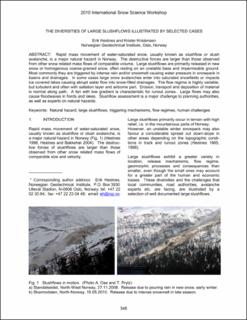| dc.contributor.author | Hestnes, Erik | |
| dc.contributor.author | Kristensen, Krister | |
| dc.date.accessioned | 2023-08-14T11:06:01Z | |
| dc.date.available | 2023-08-14T11:06:01Z | |
| dc.date.issued | 2010 | |
| dc.identifier.uri | https://hdl.handle.net/11250/3083807 | |
| dc.description.abstract | Rapid mass movement of water-saturated snow, usually known as slushflow or slush avalanche, is a major natural hazard in Norway. The destructive forces are larger than those observed from other snow related mass flows of comparable volume. Large slushflows are primarily released in new snow or homogenous coarse-grained snow, often resting on an unstable base and impermeable ground. Most commonly they are triggered by intense rain and/or snowmelt causing water pressure in snowpack in basins and drainages. In some cases large snow avalanches enter into saturated snowfields or impacts ice covered lakes causing abrupt water flow into snow-filled drainages. The flow regime is highly variable, but turbulent and often with saltation layer and airborne part. Erosion, transport and deposition of material is normal along path. A fan with low gradient is characteristic for runout zones. Large flows may also cause floodwaves in fiords and lakes. Slushflow assessment is a major challenge to planning authorities, as well as experts on natural hazards. | en_US |
| dc.language.iso | eng | en_US |
| dc.publisher | Montana State University Library | en_US |
| dc.relation.ispartofseries | The International Snow Science Workshop (ISSW) Proceedings; | |
| dc.subject | Avalanche-RnD | en_US |
| dc.subject | Snøskred-FoU | en_US |
| dc.title | The diversities of large slushflows illustrated by selected cases. | en_US |
| dc.type | Chapter | en_US |
| dc.source.pagenumber | 7 | en_US |
| dc.identifier.doi | https://arc.lib.montana.edu/snow-science/item/397 | |
